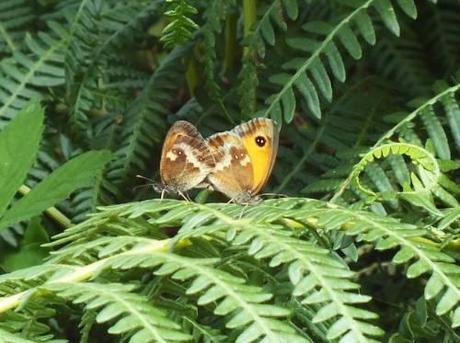Recently, I went on a trip to Newlyn Downs on a sunny day in North Cornwall, not far from Newquay and St Newlyn East. It’s a Site of Special Scientific Interest and Special Area of Conservation, and it’s not hard to see why.

Newlyn Downs (photo: Amanda Scott). The rusty red of the soils is derived from iron-rich mining spoils.

Dorset Heath, Newlyn Downs (photo: Amanda Scott)
Newlyn Downs forms the largest area in Cornwall of a vegetation type known as Southern Atlantic wet heath. It’s also the largest area of heathland in Cornwall that is rich in the nationally rare Dorset heath (Erica ciliaris). The SSSI citation gives more detail if you want to do a bit of fact-finding about what else is there. It’s a site influenced by past mining; capped lift shafts are dotted about, and the soils are a rusty red in the wetter parts of the Downs due to the iron-rich mining spoils.
My main observation, however, was that a lot of it is very boggy, and that’s fine by me as I love bogs and bog-loving plants! I was very happy as I tramped across the sphagnum.
We were on a Cornwall Butterfly Conservation field trip, and saw a fair few butterflies, moths and other species: butterflies – Gatekeeper, Brimstone, Small Skipper, Large Skipper, Meadow Brown, Small White, Large White, Small Heath, Green-veined White, Grayling; moths – Drinker (and some eggs), Magpie, and a marvelous Emperor caterpillar; other – Golden-ringed and Keeled Skimmer dragonflies. There were lots of Yellowhammers as well, perching, singing and dashing about for the benefit of the birders amongst us.

The wonderful Emperor moth caterpillar (photo: Amanda Scott)
The beauty of a field trip with a group of fellow enthusiasts is that everyone has different things to bring. We had moth, bird and plant experts with us, as well as folk who know their butterflies, and everyone was friendly and willing to share their knowledge. I learned more about how dragonflies lay their eggs in the water as we all watched a Golden-ringed female doing just that, guarded by the male.
But my main focus, I have to admit, was on the plants. It was great to see comparative rarities, such as the Dorset Heath and Babington’s Leek, but best of all was the Round-leaved Sundew, one of our native carnivorous plants. I have never ever seen so much Sundew in one place. We were all trying very hard, but without much success, not to tread on it as we walked across the boggy areas. It was flowering, but the leaves were even more impressive, postbox-red against the rusty-coloured soil, and with their sticky ‘dewdrops’ glistening prettily but with sinister intent as they wait to trap unfortunate insects.
I tweeted a photo of the Sundew, and Plantlife tweeted it as their wildflower of the day.
WILDFLOWER OF THE DAY: Sundew. Did you know that 13 carnivorous plants are native to the UK? Image c/o @AmandaScott7 http://t.co/tdLRj65uxJ—
Plantlife (@Love_plants) July 30, 2014
It’s well worth a visit to Newlyn Downs – there are clear footpaths throughout – but take your wellies or a good pair of waterproof boots! The grid reference for where to park is SW8368355209 – in the ‘lay-by’ in front of the gates to the old golf course. Cross the road and follow the signed footpath.

Bell Heather, Newlyn Downs (photo: Amanda Scott)
If you’d like to come along to a Cornwall Butterfly Conservation field trip, there are still a few more this year. Link here for a list. Everyone is assured a friendly welcome: you don’t need to be a member to attend.
Link here and here to find out more about wonderful Sundews: Plantlife’s Wildflower of the Day on 30 July, and my favorite wildflower on most days!


